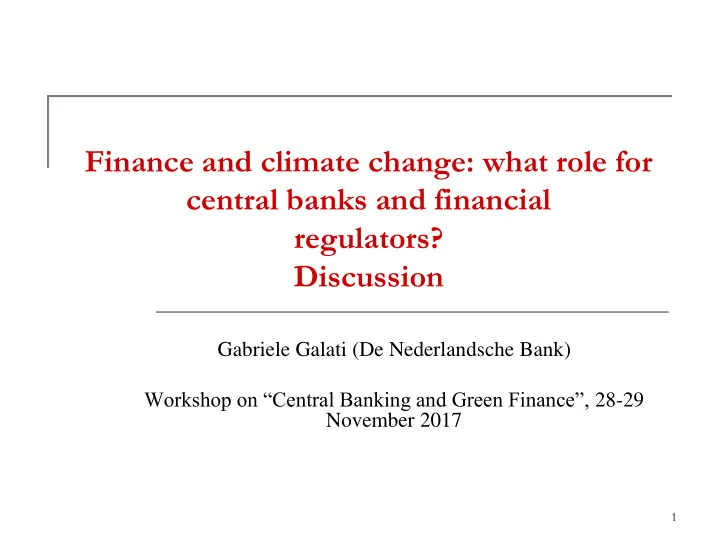

Finance and climate change: what role for central banks and financial regulators? Discussion Gabriele Galati (De Nederlandsche Bank) Workshop on “Central Banking and Green Finance”, 28-29 November 2017 1
Disclaimer: The views expressed in this presentation are mine and should not be taken to reflect those of DNB or of the Eurosystem. 2
This paper Widespread sense of urgency to prevent unmitigated climate change Shift to low-carbon economy will require financial resources to climate-friendly investments Need comprehensive set of policies aimed at delivering these financial resources Central banks can and should play a role 3
Overall assessment Interesting, insightful overview of issues Positive analysis vs normative statements Strong views on what central banks can and should do Need stronger link between normative and positive analysis My comments: key question My focus: monetary policy 4
Why central banks: externalities and mispricing There is a fundamental externality underlying the relationship between climate change and finance. Markets misprice financial assets by underpricing systemic climate-related risks to financial stability: physical risks transition risks Central banks can help addressing these risks Financial regulation Monetary policy 5
Key question Is minimizing costs in a transition to a new climate regime a new objective for central banks, or an intermediate target for a central bank that tries to support macroeconomic performance and financial stability? 6
A1: “It’s a matter of mandate” If new mandate, important issues emerge for strategy and implementation Tinbergen principle: what instruments? Effectiveness: how fine is the tuning? “Side effects”: e.g. distortionary impact of QE Accountability and credibility: impact on ability to reach price stability? Legitimacy 7
The legitimacy dilemma If central banks adopt a smooth transition to a climate-friendly regime as a target, pursuing this target would have large distributional implications. Impact on energy prices, industrial sectors, employment ... But central banks scrutinized for affecting the distribution of wealth and income without being democratically elected. 8
A2: Which horizon for monetary policy? If minimizing costs in a transition to a new climate regime is an intermediate target, this has implications for the horizon. Monetary policy is typically geared towards the medium-term Business cycle frequency ~ 2-3 years Financial cycle frequency (if focus is on climate change as channel for financial stability) ~ 4-5 up to 10-15 years Monetary policy typically not geared towards addressing structural/long-term issues Think e.g. of the discussion on the need for structural reforms to address problems underlying weak macroeconomic and financial performance What horizon do you envisage for the transition path? 9
On central banks and house prices Transition to a climate-friendly regime vs house prices not a straightforward comparison, depends on answers to above questions “It is often said that real estate is at the center of almost every financial crisis. That is not quite accurate, for financial crises can, and do, occur without a real estate crisis. But it is true that there is a strong link between financial crises and difficulties in the real estate sector” ( Stanley Fischer, 2017). Support of housing market at times of stress support financial sector and economic activity. 10
Thank you 11
Recommend
More recommend